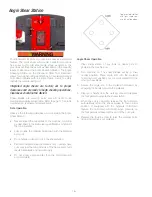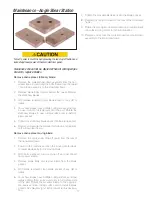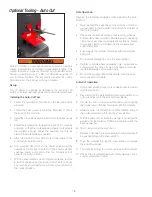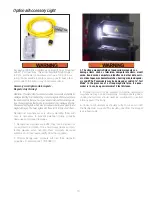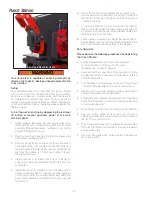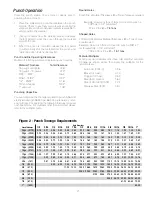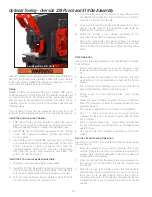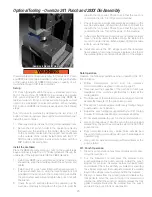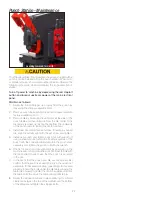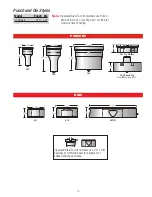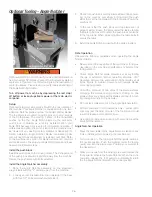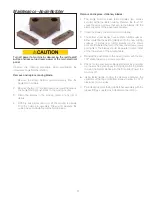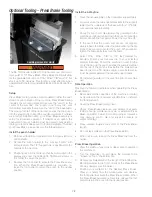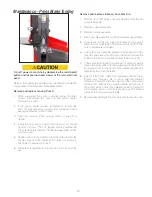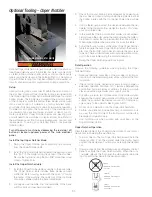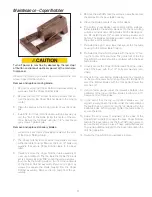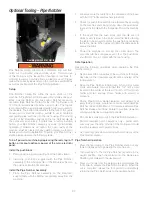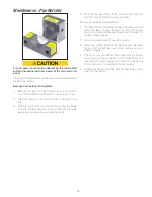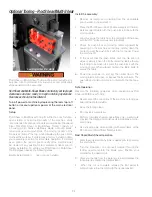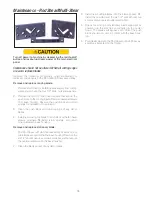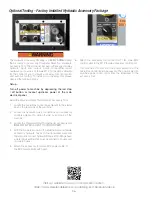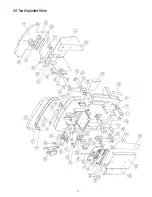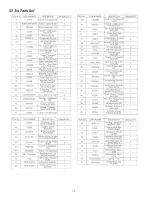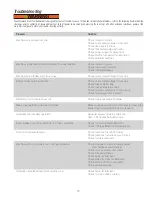
30
Optional Coper Notcher tooling will provide a distortion and burr
free, three-sided shear cut to mild steel bar, plate, or angle stock
as listed in the machine specifications as well as the capacity
labels positioned adjacent to the Notching Station. The optional
Coper Notcher tooling for a Cleveland Steel Tool Ironworker al-
lows for shaped, straight or angled notch cutting applications.
Setup
Optional tooling and accessories fit within the open station of
the machine. Optional Coper Notcher tooling is equipped with
one, three-sided top Coper Notcher blade and three, four-sided
bottom blades. The top blade is mounted to the moving “center”
of the ironworker, while the bottom three blades are secured
into a base housing. If ordered as a factory installed option,
your Coper Notcher assembly is setup for immediate operation.
If ordered as an option, the open cavity of the machine must
be cleared of any existing tooling, material or debris prior to
tooling installation. Coper Notcher blades are wearing parts
and will need to be maintained or replaced over time. Refer to
the maintenance section for blade maintenance, removal and
replacement. To setup your Notching Station, observe the
following steps:
Turn off power to machine by depressing the red stop / off
button or lockout upstream power at the main electrical
panel.
Install the top Coper Notcher blade:
1. Swing the Coper Notcher guard assembly up and away
from the Coper Notcher table.
2. Install the top Coper Notcher blade with the keyway up and
the “foot” of the blade facing the center of the machine.
Secure the top blade using the two 3/8" socket head cap
screws. Tighten bolts.
Install the Coper Notcher table:
1. Install the Coper Notcher table assembly to the base table.
The Coper Notcher table includes three blades secured
within the table housing. Install with the open “U” facing
the center of the machine. The guide foot of the top blade
should be centered within the base table blades.
2. Loosely secure the table from the underside of the base
with four bolts and washers (provided).
3. Check for top and bottom blade alignment by powering up
the machine and slowly inching down the top blade to meet
the bottom blades with the foot pedal. Power the machine
off.
4. Using a feeler gauge, adjust the clearance between the pe-
rimeter of the top and bottom blades to allow for .010" clear-
ance on all three sides.
5. In the event that the top and bottom blades are not aligned,
simply loosen the bolts under the table allowing the table to
be moved to center the top blade within the bottom blades.
When aligned, tighten the table bolts to secure the table.
6. Adjust the four set screws at the sides of the Coper Notcher
table to engage the base Coper Notcher table to the base ta-
ble. Lock the four 3/8" nuts in place to secure the set screws
in place. These added fixtures are to provide additional sup-
port to the base table during the notching operation.
7. Swing the Coper Notcher guard back in place.
Safe Operation
Observe the following guidelines when operating the Coper
Notcher Station.
• Never exceed the capacities of the machine or tooling as
described in the Ironworker specifications or listed at the tool-
ing station.
• Check notcher blade clearance at every tooling change or
extended operation. Maintain .010" clearance between top
and bottom notcher blades at all times. Failure to maintain
clearance will damage blades and support pockets.
• Cut with a minimum two of three sides of the blade surfaces
engaging the material being notched. Cutting on one blade
surface may overload the blades and result in tooling dam-
age or injury to the operator. See Figures A,B,C.
• Do not stack material to cut in the Coper Notcher station.
• Perform complete notch operations only – partial notch cuts
may jam the drop off side of the tooling and could result in
breakage and operator injury.
• Use notching aids when working with small items at the
Coper Notcher station.
Coper Notcher Operation
Clear the feed table of the Coper Notcher station of any tools or
debris prior to powering the machine on.
1. Turn machine on. The top Coper Notcher blade will be in the
neutral position. Push the material under the tooling guard
and into the blade area. Position your material to the desired
cut.
2. Clear your hands from the working area and depress the foot
pedal to activate the Coper Notcher station. When the cut is
complete, release the foot pedal to automatically return the
top Coper Notcher blade to the neutral position.
Optional Tooling - Coper Notcher
Figure A
Incorrect use
- material supported
on one blade
Figure B
Correct use
- material supported
by two blades
Figure C
Correct use
- material supported
by three blades
Guarding removed for clarity
Summary of Contents for 55 Ton
Page 2: ......
Page 41: ...37 55 Ton Exploded View ...
Page 42: ...38 55 Ton Parts List ...
Page 44: ...40 www clevelandsteeltool com 474 E 105th St Cleveland OH 44108 800 446 4402 ...

